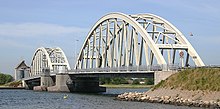COWI
| COWI Holding A / S
|
|
|---|---|
| legal form | Corporation |
| founding | 1930 |
| Seat |
Kongens Lyngby , Denmark |
| management | Lars Peter Søbye ( CEO ) |
| Number of employees | 6600 |
| sales | 6,151 million DKK |
| Branch | engineering |
| Website | www.cowi.com |
| Status: 2017 | |
COWI is the largest Scandinavian engineering company for construction with branches worldwide. The seat is in Lyngby near Copenhagen . It was founded in 1930 by Christians Ostenfeld .
In 2015 they had a turnover of 747 million euros. They have around 6300 employees, in addition to civil engineers and architects, as well as a large number of other specialists (geologists, sociologists, economists, etc.). Around 15 percent of the shares are with former or active employees of the company. The rest is owned by the foundation. Lars Peter Søbye has been CEO since 2008. In total, they were involved in around 50,000 projects in 175 countries by 2017. They have offices in 35 countries.
They also advise on environmental and climate issues, economic issues and the energy sector. In 2009, for example, on behalf of the EU, they analyzed the effects of the EU's climate protection measures on developing countries, the environmental impact of the planned Fehmarnbelt connection and they also provided sociological studies, for example in 2008/09 on the improvement of working and prison conditions in Danish prisons and investigated in 2007 until 2008 sexual discrimination in the EU.
history
Christen Ostenfeld (1900–1976) was the son of the reinforced concrete pioneer and civil engineering professor Asger Ostenfeld . He returned to Denmark in 1930 after several years abroad and founded the engineering office in his apartment as a one-man business. The first order in 1931 was the conversion of the National Scala, for which he used reinforced concrete in order to be able to meet the deadlines. The inauguration took place in 1931 with 2000 guests. After this first success, he constructed the Aggersund Bridge over the Limfjord, inaugurated in 1942 (a steel arch bridge with 150 m span, the first large bridge in Denmark designed by an engineering company from the private sector, previously the monopoly was with the Danish State Railways). In 1938 the KB Hallen followed (in Copenhagen, Frederiksberg), known in the 1950s and 1960s for many rock concerts such as the only Beatles concert in Denmark. At that time it was the largest private sports complex in Europe with 5,000 seats. In 1946 Wriborg W. Jønson became a partner and the company was called Chr. Ostenfeld & W. Jønson . At that time there were 25 employees. In the 1940s, the well-known soil mechanic Laurits Bjerrum headed the foundation engineering department.
They were also known for cylindrical silos made of prestressed concrete (Ostenfeld Silo), which made it possible to significantly reduce wall thicknesses (around 25 cm). One example is the 85 m high Carlsberg Silo in Copenhagen (Vesterbro) from 1956/57.
Another milestone was the prestressed concrete suspension bridge in Uittamo in Finland (1960), especially for the company's bridge construction division. COWI became a leader in Scandinavia and began to expand worldwide (Ghana, Paris). They constructed Ny Lillebæltsbro , built between 1965 and 1970, across the Little Belt, and planned the Storebæltsbroen across the Great Belt. The latter is one of the longest suspension bridges in the world with a span of over 1600 m (in operation from 1998). The designer at the latter was Klaus Ostenfeld , the founder's nephew, who also took over the management of the company. Another major project of the company was the Copenhagen Metro from 1994 to 2002. COWI was responsible for the overall planning and monitoring.
After Christian Ostenfeld retired in 1972, the company became COWIconsult. In 1979 there were 800 employees and a third of sales were made abroad, including the Soviet Union, Africa and the Middle East. In particular after the fall of the Wall in Eastern Europe, COWI expanded with branches in Moscow, Latvia, Lithuania and Hungary. One example is the Kuryanovo sewage plant in Moscow (1992). Wastewater treatment plants were another focus of COWI. In addition, they have always been strong in port and bank construction.
In 2002 two leading Scandinavian engineering offices were taken over, Kampsax and Interconsult. In 2009 the takeover of the Swedish company Flygfolksbyrån followed and in 2014 the English tunneling specialist Donaldson Associates.
Other projects were the Tanzam Highway in Tanzania (2005), the London Array (2009) and the Doha Metro in Qatar (2013).
In 2017 they took over the British company Flint & Neill (founded in 1958, known for the Lotus Temple in New Delhi, the National Theater in London, the reinforcement of the West Gate Bridge and the Bridge of Aspiration in the Royal Ballet School).
Other Projects:
- Alssundbroen
- Bahrain Financial Tower
- Copenhagen Concert Hall
- Skuespilhuset of the Danish National Theater in Copenhagen (Architects Lundgaard and Tranberg, 2008)
- Osman Ghazi Bridge
- Pont de Normandie
- Muscat airport and opera
- Widening of Motorring 3 in the north of Zealand
Web links
Individual evidence
- ↑ a b COWI in letter. (PDF) COWI Holding A / S, April 6, 2018, accessed on September 10, 2018 (English).


